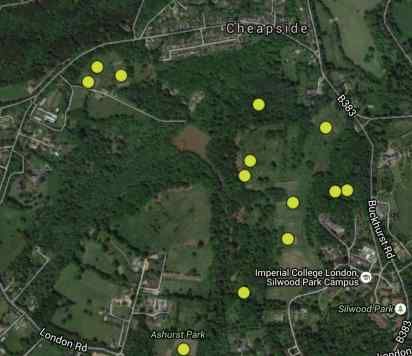Understanding whether natural populations can adapt fast enough to climate change is one of the more challenging question in ecology and environmental sciences. The timing of key events in organisms' lifetime has evolved to synchronize with abundance patterns of their preys and natural enemies. Consequently, changes in climate and environmental cues can create a mismatch in phenology between interacting species threatening the stability of food chains and ecosystems.
European Blue tits (Cyanistes caeruleus) time reproduction so the period for rearing chicks is synchronized with the peak of abundance of caterpillars, most of which feed on young leaves of deciduous trees. A long-term study at Silwood Park aims to understand the extent to which a mismatch between breeding phenology and prey availability affects a wild population of these birds. Hundreds of nest boxes and thousands of oak trees distributed across the campus' woodlands are monitored annually since 2002 to track the breeding activity of nesting tits and record the time of emergence of new oak leaves.
The blue tit project is one of the experiments of the Georgina Mace Centre for the Living Planet and the Studies of Populations of Individual Birds Network & Database (SPI-Birds). It was created by Professor Ian Owen in 2002 and managed by Dr. Alex Lord until 2015. This project is currently led by Dr. Julia Schroeder and supported by the Department of Life Sciences at Imperial College London.
Blue and great tit nest boxes
details blue tit projec
Hadfield JD, Burgess MD, Lord A, Phillimore AB, Clegg SM, Owens IP (2006) Direct versus indirect sexual selection: genetic basis of colour, size and recruitment in a wild bird. Proceedings of the Royal Society B: Biological Sciences 273: 1347–1353.
Hadfield JD, Owens IPF. 2006. Strong environmental determination of a carotenoid-based plumage trait is not mediated by carotenoid availability. Journal of Evolutionary Biology 19: 1104–1114.
Hadfield JD, Nutall A, Osorio D, Owens IPF. 2007. Testing the phenotypic gambit: Phenotypic, genetic and environmental correlations of colour. Journal of Evolutionary Biology 20: 549–557.
Bell SC, Owens IPF, Lord AM (2014) Quality of breeding territory mediates the influence of paternal quality on sex ratio bias in a free-living bird population. Behavioral Ecology 25: 352–358.
Thorley JB, Lord AM (2015) Laying date is a plastic and repeatable trait in a population of blue tits Cyanistes caeruleus. Ardea 103 (1): 69-78
Villemereuil PD et al. (2020) Fluctuating optimum and temporally variable selection of breeding date in birds and mammals. PNAS: 117: 31969-31978
Culina A, et al. (2021) Connecting the data landscape of long-term ecological studies: The SPI-Birds data hub. Journal of Animal Ecology 90: 1997-2226
Chik HYJ, Estrada C, Wang Y, Tank P, Lord AM, Schroeder J (2022) Individual variation in reaction norms but no directional selection in reproductive plasticity of a wild passerine population. Ecology and Evolution 12: e8582
Data from blue tits breeding in the experimental nest boxes set around Silwood Park grounds has been collected since 2002. Core data includes:
- Date of the first egg laid
- Number of eggs laid (clutch size)
- Morphological measures of the breeding couple and all offspring
- Nesting success
Adults and fledglings are marked with individually numbered BTO rings.
The leaf-out phenology of a proportion of tagged oak trees (Quercus robur) is annually monitored from March to June to register the date of six stages from bud burst to fully extended and hardened leaves.
For details of data available check the BlueTit_metadata and the Oaks_metadata
There is a network of woodcrete nest boxes across the campus’ woodlands used to study the breeding phenology of blue tits. Most boxes have a small entrance (26 mm) but two of woodlands have also a set of boxes with a larger entrance (32 mm). Boxes with larger entrances can be used by Great Tits and all nest boxes are occasionally occupied by Nuthatches and Coal Tits. Nest boxes have a unique name with a letter and a number. Letters of boxes of the same entrance size and within the same woodland have the same letter. The Number of nest boxes have varied throughout the study. Two third of them where placed on 2002, followed by more added between 2004 and 2010. In 2022 breeding season there were 224 active nest boxes, 176 boxes have a 26 mm. From April to June each nest box is monitored follow the breeding activity of Blue and Great Tits.
In addition, about 1000 oaks (Quercus robur) distributed across of Silwood Park woodlands are marked and their leaf phenology followed during the season. Oak shoots and new leaves are the food of caterpillars like the winter moth (Operophtera brumata), which are a key resource for the growing chicks.




